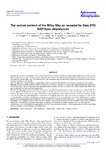Mostrar o rexistro simple do ítem
The cerium content of the Milky Way as revealed by Gaia DR3 GSP-Spec abundances
| dc.contributor.author | Contursi, G. | |
| dc.contributor.author | Laverny, Patrick de | |
| dc.contributor.author | Recio-Blanco, A. | |
| dc.contributor.author | Spitoni, Emanuele | |
| dc.contributor.author | Palicio, Pedro Alonso | |
| dc.contributor.author | Poggio, Eloisa | |
| dc.contributor.author | Grisoni, V. | |
| dc.contributor.author | Cescutti, Gabriele | |
| dc.contributor.author | Matteucci, Francesca | |
| dc.contributor.author | Spina, L. | |
| dc.contributor.author | Álvarez, M. A. | |
| dc.contributor.author | Kordopatis, Georges | |
| dc.date.accessioned | 2023-04-11T10:39:37Z | |
| dc.date.available | 2023-04-11T10:39:37Z | |
| dc.date.issued | 2023 | |
| dc.identifier.citation | G. Contursi, M.A. Álvarez, et al., "The cerium content of the milky way as revealed by gaia DR3 GSP-spec abundances", Astronomy and Astrophysics, 670, 2023. doi:10.1051/0004-6361/202244469 | es_ES |
| dc.identifier.uri | http://hdl.handle.net/2183/32845 | |
| dc.description.abstract | [Abstract]: The recent Gaia third data release contains a homogeneous analysis of millions of high-quality Radial Velocity Spectrometer (RVS) stellar spectra by the GSP-Spec module. This led to the estimation of millions of individual chemical abundances and allows us to chemically map the Milky Way. The published GSP-Spec abundances include three heavy elements produced by neutron-captures in stellar interiors: Ce, Zr, and Nd. Aims. We study the Galactic content in cerium based on these Gaia/RVS data and discuss the chemical evolution of this element. Methods. We used a sample of about 30 000 local thermal equilibrium Ce abundances, selected after applying different combinations of GSP-Spec flags. Based on the Gaia DR3 astrometric data and radial velocities, we explore the cerium content in the Milky Way and, in particular, in its halo and disc components. Results. The high quality of the Ce GSP-Spec abundances is quantified through literature comparisons. We found a rather flat [Ce/Fe] versus [M/H] trend. We also found a flat radial gradient in the disc derived from field stars and, independently, from about 50 open clusters. This agrees with previous studies. The [Ce/Fe] vertical gradient was also estimated. We also report an increasing [Ce/Ca] versus [Ca/H] in the disc, illustrating the late contribution of asymptotic giant branch stars with respect to supernovae of type II. Our cerium abundances in the disc, including the young massive population, are well reproduced by a new three-infall chemical evolution model. In the halo population, the M 4 globular cluster is found to be enriched in cerium. Moreover, 11 stars with cerium abundances belonging to the Thamnos, Helmi Stream, and Gaia-Sausage-Enceladus accreted systems were identified from chemo-dynamical diagnostics. We found that the Helmi Stream might be slightly underabundant in cerium compared to the two other systems. Conclusions. This work illustrates the high quality of the GSP-Spec chemical abundances, which significantly contribute to unveiling the heavy-element evolution history of the Milky Way. | es_ES |
| dc.description.sponsorship | We thank the referee for their valuable comments. ES received funding from the European Union’s Horizon 2020 research and innovation program under SPACE-H2020 grant agreement number 101004214 (EXPLORE project). ARB also acknowledges support from this Horizon program. PAP and EP thanks the Centre National d’Etudes Spatiales (CNES) for funding support. VG acknowledges support from the European Research Council Consolidator Grant funding scheme (project ASTEROCHRONOMETRY, G.A. n. 772293, http://www.asterochronometry.eu ). Special thanks to Niels Nieuwmunster and Botebar for grateful comments on figures. This work has made use of data from the European Space Agency (ESA) mission Gaia ( https://www.cosmos.esa.int/gaia ), processed by the Gaia Data Processing and Analysis Consortium (DPAC, https://www.cosmos.esa.int/web/gaia/dpac/consortium ). Funding for the DPAC has been provided by national institutions, in particular the institutions participating in the Gaia Multilateral Agreement. | es_ES |
| dc.language.iso | eng | es_ES |
| dc.publisher | EDP Sciences | es_ES |
| dc.relation | info:eu-repo/grantAgreement/EC/H2020/101004214 | es_ES |
| dc.relation | info:eu-repo/grantAgreement/EC/H2020/772293 | |
| dc.relation.uri | https://doi.org/10.1051/0004-6361/202244469 | es_ES |
| dc.rights | Atribución 4.0 Internacional (CC BY 4.0) | es_ES |
| dc.rights.uri | http://creativecommons.org/licenses/by/3.0/es/ | * |
| dc.subject | Galaxy: abundances | es_ES |
| dc.subject | Galaxy: disk | es_ES |
| dc.subject | Galaxy: evolution | es_ES |
| dc.subject | Galaxy: halo | es_ES |
| dc.subject | Stars: abundances | es_ES |
| dc.title | The cerium content of the Milky Way as revealed by Gaia DR3 GSP-Spec abundances | es_ES |
| dc.type | info:eu-repo/semantics/article | es_ES |
| dc.rights.access | info:eu-repo/semantics/openAccess | es_ES |
| UDC.journalTitle | Astronomy and Astrophysics | es_ES |
| UDC.volume | 670 | es_ES |
| dc.identifier.doi | 10.1051/0004-6361/202244469 |
Ficheiros no ítem
Este ítem aparece na(s) seguinte(s) colección(s)
-
GI-LIA2 - Artigos [58]
-
OpenAIRE [359]






